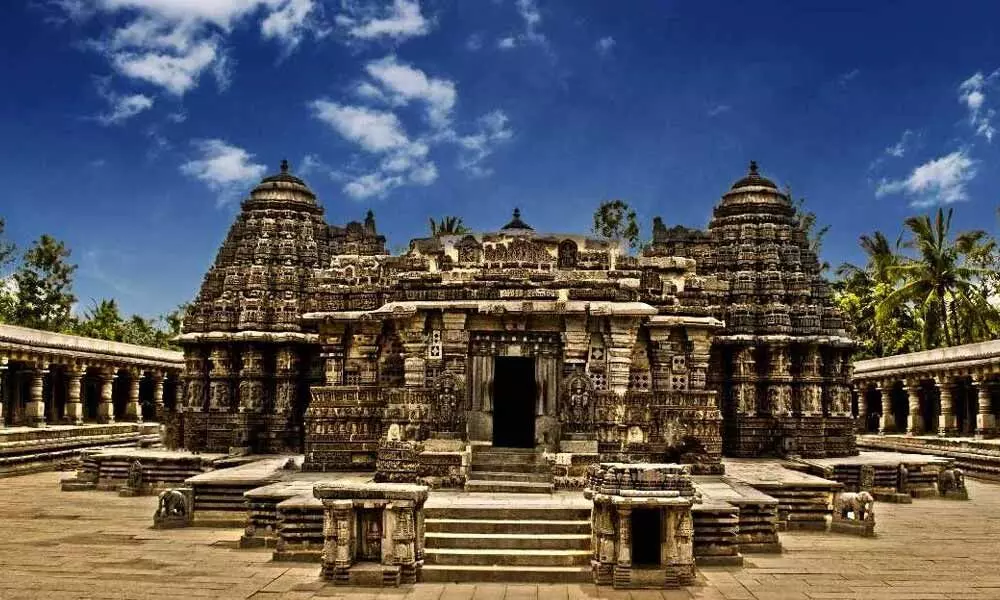Live
- Jain Monk Shri 108 Jnaneshwar Muni Attains Samadhi at Devlapur
- Meet DJ Yogi: The Favorite DJ of Bollywood Celebrities and Sports Stars
- Synergy Marine Group Champions Onboard AI Agriculture for Healthier Crews and a Greener Future
- BJP alleges Rs 45 cr scam by AAP govt in school construction
- Yashoda Medicity organizes “Crown of Courage” ceremony to honor Cancer Survivors
- AAP appoints two-time legislator Arora as Punjab chief
- BJP won’t succeed in toppling Congress govt: K’taka Home Minister
- Turkey neutralises five Kurdish militants in Syria
- BJP questions Kejriwal on 21,000 deaths in Delhi due to contaminated water
- CM Revanth Reddy Inspects Progress of Telangana Mother Statue Installation
Just In
Hoysala temples nominated for Unesco World Heritage sites


Hoysala temples nominated for Unesco World Heritage sites
The elegant Hoysala temples of Belur, Halebid and Somnathapura in Karnataka have been finalised for nomination for the Unesco World Heritage sites for the year 2022-2023, Union Minister for Culture, Tourism and Development of North Eastern Region G. Kishan Reddy said.
Bengaluru: The elegant Hoysala temples of Belur, Halebid and Somnathapura in Karnataka have been finalised for nomination for the Unesco World Heritage sites for the year 2022-2023, Union Minister for Culture, Tourism and Development of North Eastern Region G. Kishan Reddy said.
He broke the news on Monday night by puting out tweets in Kannada and Hindi, which doubled the celebration of Kannadigas.
He said: "The 'Sacred Ensembles of Hoysala' have been on UNESCO's tentative list since April 15, 2014. Let us sincerely pray that these temples get inscribed as World Heritage in 2023.
"These temples represent one of the highest points of human creative genius and stand testimony to the rich historical and cultural heritage of our country. My hearty congrats to all those involved in this exercise."
India's ambassador and permanent representative to UNESCO Vishal V. Sharma, said: "India is proud to nominate the 'Sacred Ensembles of Hoysala' for UNESCO's World Heritage List! Art Historians recognise the exceptional sculptural artistry of the ensembles to be among masterpieces of Asian rt." The Hoysala temples represent human creative genius and stand testimony to the rich historical and cultural heritage of our country.
Vishal V. Sharma formally submitted the nomination dossier to UNESCO's Director of World Heritage, Lazare Eloundou on Monday.
After this, the UNESCO will respond by early March, conduct site evaluation in September/October and finally take up the dossier for consideration in July/August next year.
Talking about the Prime Minister's efforts in protecting the rich cultural heritage of India, Kishan Reddy said: "The Government under the leadership of Prime Minister Narendra Modi is committed to both Vikas and Virasat. Our efforts in protecting our Virasat is evident from the work the government has been putting in inscribing both our tangible and intangible heritage and also repatriating the cultural heritage that was stolen or taken away from India."
The three Hoysala temples are protected monuments under the Archaeological Survey of India (ASI) and therefore conservation and maintenance is done by the ASI. The State government will ensure the conservation of state protected monuments which are around these three temples, since it would add to the visual integrity of the place.
It will also build an integrated management plan by incorporating the buffers of all monuments in the District Master Plan and look at the traffic management issues, especially around the designated property.
The Hoysalas temples were built in the 12th-13th century and are represented here by the three components of Belur, Halebid and Somnathpur. They also attest to the creativity and skill of the Hoysala artists and architects who built these one of a kind masterpieces.
These architects used their profound knowledge of temple architecture from across India to their advantage.
These temples have a basic Darvidian morphology but show strong influences of the Bhumija mode widely practiced in central India, the Nagara traditions of northern and western India, and the Karnataka Dravida modes favoured by the Kalyani Chalukyas.
Therefore, the Hoysala architects considered eclectic selections of features from other temple typologies which they further modified and complemented with their own particular innovations. The result was the birth of a completely novel 'Hoysala Temple' form.

© 2024 Hyderabad Media House Limited/The Hans India. All rights reserved. Powered by hocalwire.com






